Custom Built Customization is one way to change the appearance of a motorcycle to be different from the factory default. Almost all components are made by hand, without deifying the aftermarket accessories available in the market.
 |
| A modified Yamaha XSR 155 done by Pap N Mam in a modern flat track style. (Picture from: Viva) |
 By utilizing the builders or experts to make a custom motorbike, some manufacturers are interested in changing their products to attract the attention of consumers.
By utilizing the builders or experts to make a custom motorbike, some manufacturers are interested in changing their products to attract the attention of consumers. As has been done by the world's famous Japanese motorcycle brand Yamaha (in Indonesia) through PT Yamaha Indonesia Motor Manufacturing (YIMM) took in collaboration with several well-known custom motorcycle workshops in the country. And one of its latest custom projects is with Pap N Mam.
 The Yamaha XSR 155 has a neo retro design that can attract attention, but in the hands of Hendra Cahyono of a motorcycle builder and owner of Semarang-based workshop named Pap N Mam, the Yamaha XSR was changed to a modern flat track.
The Yamaha XSR 155 has a neo retro design that can attract attention, but in the hands of Hendra Cahyono of a motorcycle builder and owner of Semarang-based workshop named Pap N Mam, the Yamaha XSR was changed to a modern flat track.Hendra said that the Yard Built event is a place for builders and modifiers to be able to realize their dreams of developing motorcycles, which are in accordance with their own wishes.“In this Yard Built program, I carry the Modern Flat Track concept. Through this creation, I can express my ideas and innovations as a whole. All ideas and ideas about developing the bike according to my wishes came true. It's like saying, this is really my motorbike," he said, quoted by VIVA Otomotif Friday, December 31, 2021.
In the process of changing, Hendra played a lot in the legs area. So on the legs the changes look very striking. So that it doesn't look short, then he adds or connects the wheelbase of the XSR 155 motorbike back up to 10 cm (extended swingarm).
In the process of changing, Hendra played a lot in the legs area. So on the legs the changes look very striking. So that it doesn't look short, then he adds or connects the wheelbase of the XSR 155 motorbike back up to 10 cm (extended swingarm).
 |
| Hendra Cahyono of Semarang-based workshop Pap N Mam while on work to custom the Yamaha XSR 155. (Picture from: Viva) |
Thus, the dimensions of the XSR 155 will be longer. To make it look more manly, Hendra pinned various knick-knacks on the XSR 155 he changed. For the appearance of the headlights and taillights, he carries the concept of a pop up style headlamp, where the lights can open and close automatically.
 Then embed the exhaust header with titanium material equipped with exhaust valvetronic features and custom aluminum cylinders. And so that it looks macho even when parked, Hendra has attached a side standard that is equipped with the ESS (Electronic Side Stand) feature. "The reason is because in my work, safety features must still be considered. That's why I pinned the ESS feature on the side," as Hendra concluded then.
Then embed the exhaust header with titanium material equipped with exhaust valvetronic features and custom aluminum cylinders. And so that it looks macho even when parked, Hendra has attached a side standard that is equipped with the ESS (Electronic Side Stand) feature. "The reason is because in my work, safety features must still be considered. That's why I pinned the ESS feature on the side," as Hendra concluded then.
 Then embed the exhaust header with titanium material equipped with exhaust valvetronic features and custom aluminum cylinders. And so that it looks macho even when parked, Hendra has attached a side standard that is equipped with the ESS (Electronic Side Stand) feature. "The reason is because in my work, safety features must still be considered. That's why I pinned the ESS feature on the side," as Hendra concluded then.
Then embed the exhaust header with titanium material equipped with exhaust valvetronic features and custom aluminum cylinders. And so that it looks macho even when parked, Hendra has attached a side standard that is equipped with the ESS (Electronic Side Stand) feature. "The reason is because in my work, safety features must still be considered. That's why I pinned the ESS feature on the side," as Hendra concluded then.Kept spur your adrenaline on the power of the two-wheeled monster and
stay alive with true safety riding. May God will forgive Your sins and
so does the cops...... *** [EKA | FROM VARIOUS SOURCES | VIVA.CO.ID | OTOMOTIF.KOMPAS | 100KPJ.COM | OTOPLUS ]
Note:This blog can be accessed viayoursmartphone.






































